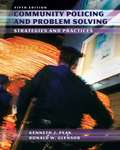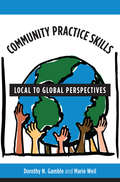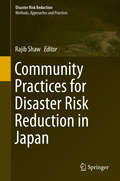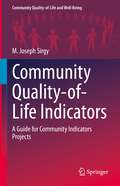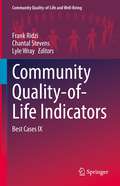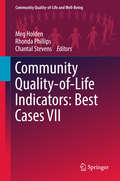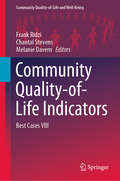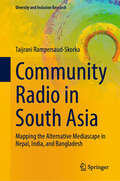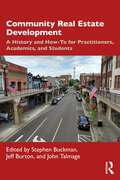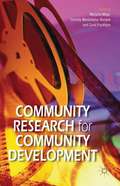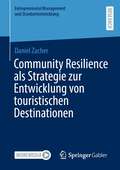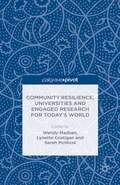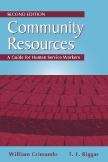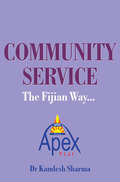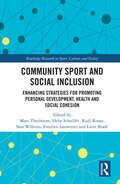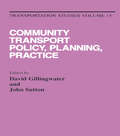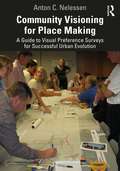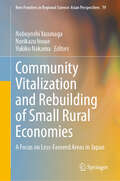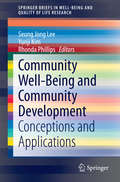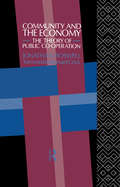- Table View
- List View
Community Policing and Problem Solving: Strategies and Practices (5th edition)
by Kenneth J. Peak Ronald W. GlensorThis book is about policing at its most important and challenging levels--in neighborhoods and in communities across the nation and abroad. Unique in perspective, its focus is on community policing and problem solving-and the processes that are being implemented under COPPS to control and prevent crime, disorder and fear. Extremely applied, this book focuses on daily processes and tactics and how and why agencies are revolutionizing their traditional philosophy and operations. This fifth edition provides updated information on crime in the United States, more emphasis on terrorism and homeland defense, and a new chapter on information technology. Authoritative and practical perspective combines the classroom expertise of a seasoned criminal justice educator with the practical experience of an executive-level police administrator. Community-oriented policing and problem solving (COPPS) focus provides a comprehensive view of how agencies are changing their management style, organizational structures, and operational strategies to attack crime, disorder and fear. Includes topics such as computer-aided dispatch, mobile computing, records management, geomapping, CompStat, global positioning systems, use of the Internet, and surveys. Police practictioners with a fundamental knowledge of police history or operations or those working in a government agency outside policing and are interested in learning about community policing and problem solving.
Community Policing, 3rd Edition
by Victor E. Kappeler Robert Trojanowic Larry K. GainesWe have attempted to extend the road map that the father of community policing sketched and bring it back into contemporary focus.
Community Policing: A Contemporary Perspective (Sixth Edition)
by Victor E. Kappeler Larry K. GainesCommunity policing is a philosophy and organizational strategy that expands the traditional police mandate of fighting crime to include forming partnerships with citizenry that endorse mutual support and participation. The first textbook of its kind, Community Policing: A Contemporary Perspective delineates this progressive approach, combining the accrued wisdom and experience of its established authors with the latest research based insights to help students apply what is on the page to the world beyond. 'Spotlight on Community Policing Practice' sections feature real-life community policing programs in various cities, and problem-solving case studies cover special topics. The text has been revised throughout to include the most current developments in the field such as how the current climate of suspicion associated with terrorism threats affects the trust so necessary for community policing, and how the newest technologies can be harnessed to facilitate police interactions with citizens. Additionally, the book now explores the fragmentation of authority and emphasizes the importance of partnerships among the numerous law enforcement agencies, government agencies, and private social service agencies. Community policing expands the police mandate beyond fighting crime to include solving community problems in partnership with citizens. New edition is updated and revised, and has new coverage of: community policing, terrorism, and homeland security; community policing and technology; and community policing and the fragmentation of authority. Study aids in the book include key concepts, learning objectives, chapter summaries, and discussion questions. Online study aids include self-quizzing, topic-specific case studies that help students turn theory into practice. Instructor aids include customizable lesson plans that connect chapter-based learning objectives to specific resources, text bank, powerpoint lecture slides, video clips of authors summarizing each chapter, and links to additional video and online resources.
Community Practice Skills: Local to Global Perspectives
by Marie Weil Dorothy GambleDorothy N. Gamble and Marie Weil differentiate among a range of intervention methods to provide a comprehensive and effective guide to working with communities. Presenting eight distinct models grounded in current practice and targeted toward specific goals, Gamble and Weil take an unusually inclusive step, combining their own extensive experience with numerous case and practice examples from talented practitioners in international and domestic settings.The authors open with a discussion of the theories for community work and the values of social justice and human rights, concerns that have guided the work of activists from Jane Addams and Martin Luther King Jr. to Cesar Chavez, Wangari Maathai, and Vandana Shiva. They survey the concepts, knowledge, and perspectives influencing community practice and evaluation strategies. Descriptions of eight practice models follow, incorporating real-life case examples from many parts of the world and demonstrating multiple applications for each model as well as the primary roles, competencies, and skills used by the practitioner. Complexities and variations encourage readers to determine, through comparative analysis, which model at which time best fits the goals of a community group or organization, given the context, culture, social, economic, and environmental issues and opportunities for change. An accompanying workbook stressing empowerment strategies and skills development is also available from Columbia University Press.
Community Practices for Disaster Risk Reduction in Japan (Disaster Risk Reduction)
by Rajib ShawThis book presents key lessons from community-based risk-reduction practices in Japan, a country that is often hit by disasters and that also has shown strong resilience in coping with those disasters. Japan has a strong governance system for disaster risk reduction. However, the Kobe earthquake of 1995 showed the importance of community involvement in disaster response as well as recovery. With several examples from different parts of Japan, the book elaborates on the importance of community-based risk reduction and the innovations required for sustaining some of the community approaches. The book has 13 chapters and is divided into three parts: (1) Evolution of community-based risk reduction in Japan; (2) Community-based risk-reduction issues; and (3) Case studies. The primary target groups for this book are students and researchers in the fields of environment, disaster risk reduction, and climate change studies. The book provides them with a good idea of the current research trends in the field and furnishes basic knowledge about these vital topics. Another target group comprises practitioners and policy makers, who will be able to apply the knowledge collected here to policy and decision-making.
Community Prevention of Child Labor: Evidence-based Practices to Promote the Psychological Well-being of Minors (Human Well-Being Research and Policy Making)
by Isidro Maya JariegoThis book discusses preventive actions that have led to reduction in the prevalence of child labor across the world over the 21st century. It identifies exemplary programs in the area of community prevention that have had exceptional results; for example, the involvement of children in hazardous work globally being reduced by half. It documents a wide range of contexts where concerted action has counteracted social permissiveness towards child labor, including psycho-educational interventions in preventing early school leaving and conditional cash benefits which counteract family poverty. The book presents a set of evidence-based practices that are particularly useful for psychologists, educators, and social workers. More broadly, this book is also of interest to policymakers, professionals, and activists involved in child protection policy or in implementing programs to promote the psychological well-being of children.
Community Quality-of-Life Indicators: A Guide for Community Indicators Projects (Community Quality-of-Life and Well-Being)
by M. Joseph SirgyThis training book is designed to help professionals enhance their knowledge of community quality-of-life indicators, and to develop viable community projects. Chapter 1 describes the theoretical concepts that guide the formulation of community indicator projects. Chapter 2 creates a sample community indicator project as a template of the entire process. Chapter 3 describes the planning process: how to identify sponsors, secure funding, develop an organizational structure, select a quality-of-life model, select indicators, and so on. Chapter 4 focuses on data collection. Finally, Chapter 5 describes efforts related to dissemination and promotion of community indicators projects. Written by a stalwart in the field of quality-of-life research, this book provides the tools of sound community project planning for quality-of-life researchers, social workers, social marketers, community research organizations, and policy-makers.
Community Quality-of-Life Indicators: Best Cases IX (Community Quality-of-Life and Well-Being)
by Frank Ridzi Chantal Stevens Lyle WrayThis volume continues the tradition now established since 2006, of compiling excellent research into the practice and application of community indicators in a single source volume. It focuses on the theme of the Community Indicators Consortium 2020 Summit, as a significant venue for the advancement of the practice and theory of community indicators work. It covers the conference's theme of “community resilience”, which is the capacity of all of a community’s elements to survive, adapt, and grow no matter what kinds of chronic stresses and acute shocks they experience. In keeping with the practical, “best cases” emphasis of this book series, the editors incorporate a case-based approach to chapters discussing how specific indicators, indices or series of indicators can lead to better decisions and outcomes to help communities adapt and transform in the face of challenges, helping them prepare for both the expected and the unexpected to sustain and improve quality of life, including technology and open source approaches to data sharing and data-focussed collaboration; evolving approaches that use shared indicators to improve overall community well-being and quality of life; research related to community indicators and policy, application, research, and/or practice; and techniques and approaches to measure resilience. This volume is of interest to social scientists, management professionals, social workers and policy makers working on various aspects of community indicators of quality of life and well-being. Chapter “The Cost of Sea Level Rise for the Island Community of Vinalhaven, Maine: Spurring action through collaborative data analysis” is licensed under the terms of the Creative Commons Attribution 4.0 International License (http://creativecommons.org/licenses/by/4.0/). For further details see licence information in the chapters.
Community Quality-of-Life Indicators: Best Cases VII (Community Quality-of-Life and Well-Being)
by Rhonda Phillips Meg Holden Chantal StevensThis book is the seventh volume in a series covering best practices in community quality of life indicators. The case studies and analysis in this volume demonstrate how community indicators projects today operate within a need to amplify the voice of disadvantaged communities, seriously explore the increasing use of information technology, produce positive community change and sustain these efforts over time. The work presented here spans North American and Australian community work and demonstrates how the field of community indicators has undergone a rapid evolution in only a few decades. Today as in their original formulations, community indicators projects are designed to gauge the social, economic and physical health and well-being of communities.
Community Quality-of-Life Indicators: Best Cases VIII (Community Quality-of-Life and Well-Being)
by Frank Ridzi Chantal Stevens Melanie DavernThis book offers critical insights into the thriving international field of community indicators, incorporating the experiences of government leaders, philanthropic professionals, community planners and a wide range of academic disciplines. It illuminates the important role of community indicators in diverse settings and the rationale for the development and implementation of these innovative projects. This book details many of the practical “how to” aspects of the field as well as lessons learned from implementing indicators in practice. The case studies included here also demonstrate how, using a variety of data applications, leaders of today are monitoring and measuring progress and communities are empowered to make sustainable improvements in their wellbeing. With examples related to the environment, economy, planning, community engagement and health, among others, this book epitomizes the constant innovation, collaborative partnerships and the consummate interdisciplinarity of the community indicators field of today.
Community Radio in South Asia: Mapping the Alternative Mediascape in Nepal, India, and Bangladesh (Diversity and Inclusion Research)
by Taijrani Rampersaud-SkorkaThis monograph, based on the author's successful PhD dissertation, examines the community radio (CR) landscape in Nepal, India, and Bangladesh. It introduces an inclusionary South Asia-specific framework for analyzing CR, grounded in global alternative media theories. Using a mapping methodology, the monograph presents both primary and secondary data. Secondary data, gathered through desk reviews, is organized into a Community Media Database (CMD) for South Asia, while primary data from interviews and case studies is analyzed across four thematic areas: policy environment, ownership, community, and programming. The book offers detailed country profiles, case studies profiles, and a comprehensive analysis of the thematic areas in each country. It concludes with 24 guiding principles aimed at addressing challenges and opportunities for CR in South Asia.
Community Real Estate Development: A History and How-To for Practitioners, Academics, and Students
by Stephen Buckman Jeff Burton John TalmageCommunity Real Estate Development: A History and How-To for Practitioners, Academics, and Students introduces the fundamentals of affordable housing to aspiring development professionals. From understanding the history informing today’s affordable housing programs to securing financing and partnering with public and private stakeholders, this primer equips students and emerging professionals for success in a unique area of the real estate industry. Topical chapters written by nationally recognized leaders in community real estate development (CRED) take a didactic approach, using real-life examples and case studies to provide context for reflection. Drawing on the authors’ experience as private sector developers, state and municipal housing officials, and not-for-profit executives, this versatile resource offers an insider’s perspective on creating and maintaining affordable housing in any real estate market. Features: Covers topics including community design, development policy, tax credits, land use planning, development rights, historic buildings, adaptive reuse, tax increment financing, and gentrification Presents interviews with development professionals in asset and property management, commercial real estate brokerage, and local housing authorities and government agencies Highlights winning case studies from a student competition to inspire similar classroom activities Includes a glossary of CRED-specific terminology to help readers master the language of affordable housing Contains diverse examples, planning tools, and "programs to make numbers work," with a companion website available Blending the latest academic research with hard-won insights from the field, Community Real Estate Development prepares the next generation of affordable housing professionals to continue the work of its pioneering authors and editors.
Community Research for Community Development
by Carol Packham Marjorie Mayo Zoraida Mendiwelso-BendekThis book explores the contributions that research, with refugees and with faith-based organizations for example, makes to strengthen community development and consequently promote active citizenship and social justice.
Community Resilience als Strategie zur Entwicklung von touristischen Destinationen (Entrepreneurial Management und Standortentwicklung)
by Daniel ZacherPersonen, Organisationen und Institutionen und deren funktionales Zusammenwirken spielen eine dezidierte Rolle im Aufbau von Resilienz, weshalb in der praktischen Implementierung dieses Ansatzes sowohl zentrale Koordination als auch partizipativ entwickelte und gestaltete Formate zum Tragen kommen. Diese Community Resilience ist zugleich die vorhandene Kompetenz und die wachsende Fähigkeit einer Gemeinschaft, Risiken abzuschätzen und sich in einem Umfeld weiterzuentwickeln, das von Veränderung, Unsicherheit und Unvorhersagbarkeit geprägt ist. Mit dieser Charakteristik kann Community Resilience einen Beitrag zur strategischen Destinationsentwicklung leisten, was anhand folgender Forschungsfrage untersucht wird: Inwiefern kann Community Resilience eine Strategie zur Entwicklung touristischer Destinationen darstellen? Daniel Zacher untersucht erstmalig die Vorzüge der Anwendung des Resilienz-Ansatzes in strategischen und organisationalen Fragen der Destinationsentwicklung. Dabei werden eine integrative konzeptionelle Betrachtung des Resilienz-Verständnisses für Destinationen im Spannungsfeld von ingenieurswissenschaftlicher, sozial-ökologischer und evolutionärer Perspektive dargestellt.
Community Resilience, Universities and Engaged Research for Today’s World
by Sarah Mcnicol Wendy Madsen Lynette CostiganThe increasing development of partnerships between universities and communities allows the research of academics to become engaged with those around them. This book highlights several case studies from a range of disciplines, such as psychology, social work and education to explore how these mutually beneficial relationships function.
Community Resources: A Guide for Human Service Workers
by T. F. Riggar William CrimandoWritten by credentialed practitioners, this book provides detailed explanations and descriptions of the most prominent and beneficial human-service agencies. Also included is information on agency personnel, as well as specific organizational certifications, licensing, and accreditation. It is also an invaluable aid to professional counselors for investigating agencies and/or service(s) for client referral. <P><P><i>Advisory: Bookshare has learned that this book offers only partial accessibility. We have kept it in the collection because it is useful for some of our members. Benetech is actively working on projects to improve accessibility issues such as these.</i>
Community Service The Fijian Way…: Apex Club in Fiji – Golden Jubilee
by Dr Kamlesh SharmaApex is a non-party and non-sectarian organisation open to young individuals between the ages of 18 years to 45 years. Apex was introduced to Fiji by Life Governor Justice Devendra Pathik in 1958. Lifer Pathik studied law at the University of Tasmania in Hobart in the 1950s. He was so impressed with the community service rendered by the Australian Apexians that he joined the Hobart Apex Club. On his return to Fiji, lifer Pathik decided to form an Apex Club. On 1 November 1961 at the historic meeting held at the Bank of New South Wales (now Westpac) in Suva, the seed was sown for the formation of the Apex Club. A number of Apex Clubs were then formed in Fiji and by 1986, there were twenty-one clubs chartered and functioning well. Apex Fiji continues to provide the community services to the needy and poor and celebrates its golden jubilee during November 2011, a major milestone and many more to come!
Community Solutions
by Tom Quinn Brian TrelstadCommunity Solutions was an anti-homelessness nonprofit founded in 2011 after protagonist Rosanne Haggerty grew frustrated with the limited impact of traditional housing and outreach strategies. It set an ambitious goal, reached in some partner communities, of ending homelessness. Its Built for Zero methodology helped communities across the U.S. improve their data collection, outreach, and provision of homelessness services, improving on often inefficient government processes and piecemeal solutions. The case focuses on the awarding, in April 2021, of $100 million from the MacArthur Foundation's 100% Change grant competition, and how Haggerty and her team prioritized projects and spending opportunities to maximize the grant's impact.
Community Sport and Social Inclusion: Enhancing Strategies for Promoting Personal Development, Health and Social Cohesion (Routledge Research in Sport, Culture and Society)
by Marc Theeboom Hebe Schaillée Rudi Roose Sara Willems Lieve Bradt Emelien LauwerierThis book examines sport as an inclusive and developmental environment, exploring the conditions by which community sport initiatives can promote personal development, health and social cohesion, particularly for at-risk youth. At the empirical core of the book is a multiple disciplinary study of community sport programmes in Flanders, Belgium, involving researchers from social sport sciences, social work, pedagogy and health care sciences. Drawing on this cutting-edge, realist research, the book considers the implications for sport development policy and practice around the world. The book considers community sport as a vehicle for promoting social inclusion, and the ways it allows people of all backgrounds and abilities to participate and access social and health benefits, whilst touching on key issues including monitoring and evaluation; exercise and health; youth welfare, and volunteering. This book is a fascinating reading for any student, researcher or practitioner working in sport for development, sport management, sport coaching, social work, education, sociology or urban studies.
Community Transport: Policy, Planning and Practice
by John Sutton David GillingwaterThis book explores the strategic significance of community transport, identifies and analyses the key issues which face community transport, and presents an analytical and evaluative account of the role, status and future of community transport.
Community Vision and Leadership in Practice: A Sustainable Approach (Social-Environmental Sustainability)
by Chris Maser Holly V. CampbellThis book is about building and maintaining involved, sustainable, and inclusive communities from the ground up during a period of unprecedented growth and global change. It explains the concepts and principles of community and sustainability and provides students with a framework of sustainable community planning to put into practice. It is also designed to help communities everywhere identify and reconnect the true essence of their ecological setting with the objective of raising their quality of life by increasing social, environmental, and economic sustainability. Features: Provides up-to-date frameworks for sustainable community planning processes and case studies on community planning Explains tools for sustainable planning in accessible (non-specialist) language Illustrates a roadmap to an inclusive, collaborative future Explains aspects of sustainable community planning to maximize ecological ecosystem services and climate co-benefits simultaneously Includes discussion questions and suggestions following each chapter Intended for undergraduate and graduate students taking leadership and community courses with an emphasis on sustainable practices and ethics, as well as for citizens and professionals involved in community projects related to sustainability, the authors provide a forward-thinking approach, showing readers that they are capable of making a positive impact on the future of community development through sustainable approaches and ethical leadership practices.
Community Visioning for Place Making: A Guide to Visual Preference Surveys for Successful Urban Evolution
by Anton C. NelessenCommunity Visioning for Place Making is a groundbreaking guide to engaging with communities in order to design better public spaces. It provides a toolkit to encourage and assist organizations, municipalities, and neighborhoods in organizing visually based community participation workshops, used to evaluate their existing community and translate images into plans that embody their ideal characteristics of places and spaces. The book is based on results generated from hundreds of public participation visioning sessions in a broad range of cities and regions, portraying images of what people liked and disliked. These community visioning sessions have been instrumental in generating policies, physical plans, recommendations, and codes for adoption and implementation in a range of urban, suburban, and rural spaces, and the book serves as a bottom-up tool for designers and public officials to make decisions that make their communities more appealing. The book will appeal to community and neighborhood organizations, professional planners, social and psychological professionals, policy analysts, architects, urban designers, engineers, and municipal officials seeking an alternative vision for their future.
Community Vitalization and Rebuilding of Small Rural Economies: A Focus on Less-Favored Areas in Japan (New Frontiers in Regional Science: Asian Perspectives #79)
by Nobuyoshi Yasunaga Norikazu Inoue Yukiko NakamaThis book provides new perceptions of rural community development by considering the relationships between communities and individuals. It addresses how farming and local communities can be maintained in areas facing population decline and increased in abandoned farmland. As a sequel to Farm and Rural Community Management in Less-Favored Areas, this book focuses on the conditions for rebuilding small rural economies through rural community vitalization in less-favored areas of Japan. Key topics addressed in the book include farmland liquidation and conservation, along with applicable agricultural policies, agribusiness development under a broad-based community development process, the market characteristics of locally processed foods, and the relationship between participation in broad-based community management and residents’ characteristics. The primary target are hilly and mountainous regions, such as in Shimane Prefecture, in western Japan, and other mountainous areas that are the main less-favored areas in Japan. The book presents findings from econometric and statistical analyses, historical and actual condition surveys. Academically, the book contributes to the elucidation of community-based regional management through interactions between communities, residents, farmers, and policies. It identifies conditions for rebuilding small rural economies are based on research on the characteristics of regional agriculture and rural communities in less-favored areas. This book is written for researchers, graduate students, and readers who are concerned about agriculture-based rural development in less-favored areas. It promotes both public and field-level practice in rural areas. The content will be of interest to all those seeking to understand rural society in Japan.
Community Well-Being and Community Development: Conceptions and Applications (SpringerBriefs in Well-Being and Quality of Life Research #0)
by Rhonda Phillips Seung Jong Lee Yunji KimThis briefs provides foundations of both community wellbeing and community development, and the relationships between the two areas, including both similarities and differences. Community well-being encompasses a large array of concepts and disciplines. Community development, as an established discipline, is one framework that can help further understanding of community well-being, and is an allied concept. The interaction between the two areas is worthy of exploration, as both a new way to think about community development as well as a way to understand what community well-being entails. Beginning with a discussion of the foundations, the first and second chapters provide grounding for conceptions and potential theory applications as well as constructs for moving community wellbeing forward. The remaining chapters provide applications of community well-being in the context of community development, with examples from North America and Asia. Community development focused community wellbeing policies and programs illustrate processes and outcomes.
Community and the Economy: The Theory of Public Co-operation
by Jonathan BoswellPresenting a new political and historical theory of the mixed economy, this book is a convincing argument for a challenging social ideal - democratic communitarianism. Individualistic notions of liberty, equality and prosperity are too central to modern life and they need to be balanced by values of `community' and co-operation. Arguing that such a transformation is possible and practical, the author argues that long-term changes must be achieved before economic success can take place in a more fraternal, participative, and democratic society.
